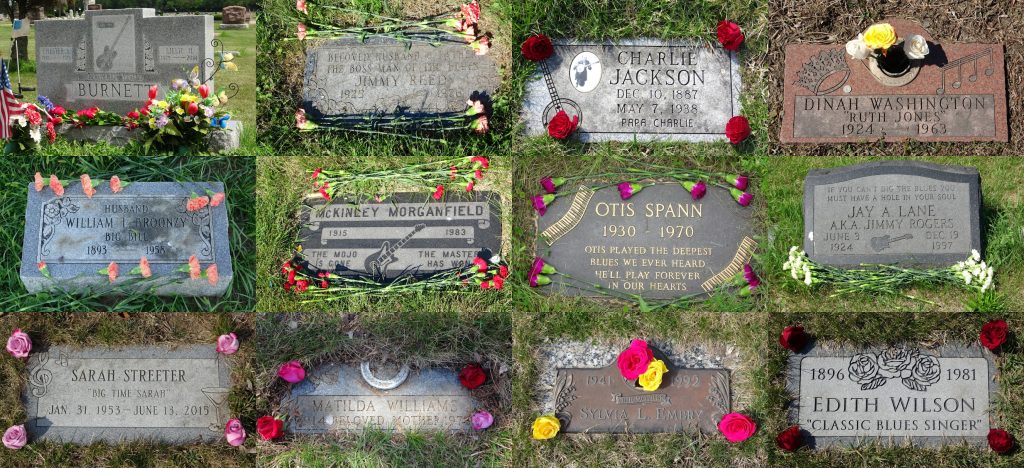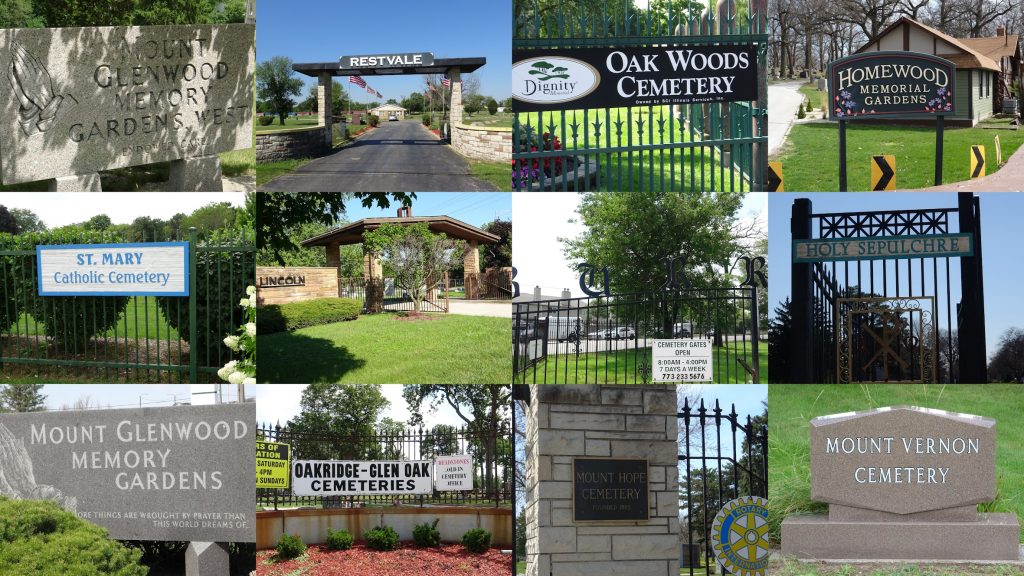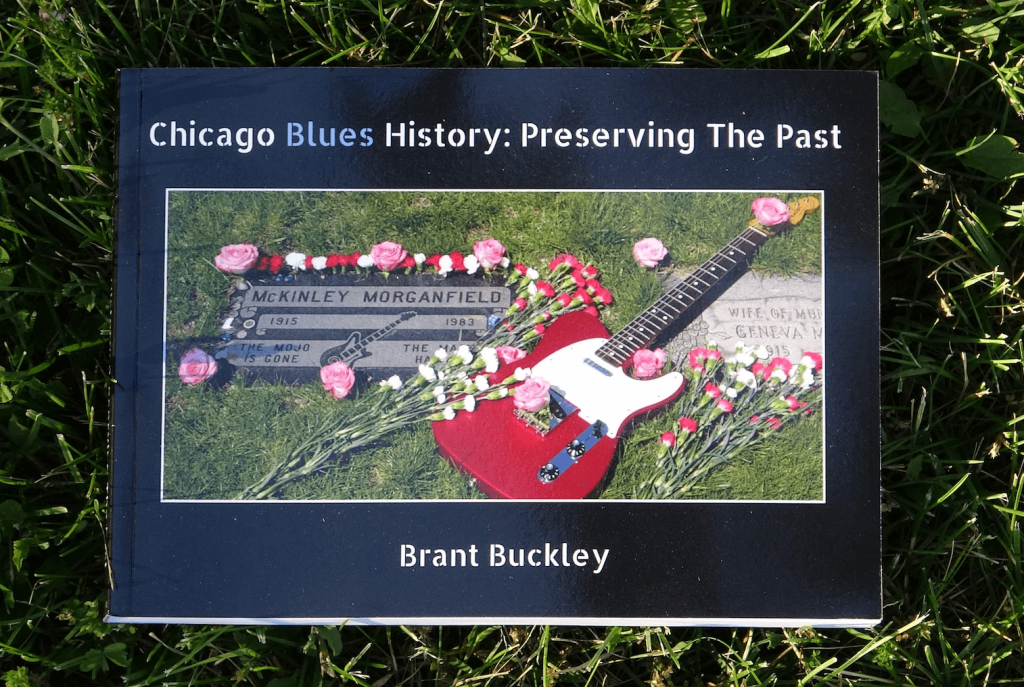In a book called Chicago Blues History: Preserving the Past, author and musician Brant Buckley takes us on a photographic grave tour honoring eighty of the greatest Chicago blues artists of all time. As he travels through fifteen cemeteries located in and around Chicago, he places flowers on their graves – each set color-coordinated based on the artist’s style. A brief description of the artist, their cause of death, and a list of their most notable songs are on the left page, with the flower-adorned grave on the right page.

Buckley’s ultimate goal with this book is that people understand how these artists molded popular music as we know it today. He writes in the introduction, “Bluesmen born in the late 1800s and early 1900s include Papa Charlie Jackson, Thomas A. Dorsey, Daddy Stovepipe, John Henry Barbee, Kansas Joe McCoy & Papa Charlie McCoy, Sunnyland Slim, and Kokomo Arnold. These men nearly invented recording, and inspired and paved the way for the next group of Chicago Blues artists.”
He continues, “The bluesmen I call the big four – Muddy Waters, Jimmy Reed, Big Bill Broonzy, and Howlin’ Wolf – gave birth to Eric Clapton, Jimmy Page, Keith Richards & Mick Jagger of The Rolling Stones, The Beatles, Bob Dylan, John Mayer, and everyone else imaginable. Willie Dixon and Fred Below are incredibly important as Dixon was the chief songwriter/producer for Chess Records, and Below played drums on nearly every hit song, creating the blues backbeat in the process.
“Also, there are powerful female blues artists who made incredible contributions. Artists include Dinah Washington, Koko Taylor, Mississippi Matilda, Queen Silvia Embry, Mama Yancey, Edith Wilson, Big Time Sarah, and Bertha Lee Patton, the wife of Charley Patton. The Chicago blues artists in this book are the source. They are the original rock n’ rollers and rappers… Blues remains hidden within countless forms of music. It is the mud underneath the earth making all forms of music sprout and grow.”
Chicago Blues History: Preserving the Past has been nine years in the making. His first draft consisted of 21 artists, and he shelved it due to no interest from publishing companies. But about six months ago, while in deep meditation, he heard his inner voice tell him to finish. “I then created an Excel spreadsheet with 120 Blues artists buried near Chicago. I decided to ramp the book up to 80 artists. I added 60 more new people,” Buckley tells me.
“A lot of the graves had GPS coordinates online and many did not. I felt like I was on a blues grave treasure hunt, and trust me this was not easy; the book tested my sanity. A lot of the coordinates were incorrect and I would spend forty minutes to an hour searching for one grave. Sometimes, I couldn’t locate artists as some were completely buried, submerged, and lost in time. I had a tremendous amount of help from cemetery grave workers and staff. I met many interesting and great people along the journey.”

The book features famous artists including Muddy Waters, Jimmy Reed, Koko Taylor, Big Bill Broonzy, Howlin’ Wolf, Jimmy Reed, and Willie Dixon. But he tried to dig deeper for the unknowns who also made tremendous contributions. Kokomo Arnold, who delivered rapid-fire vocals and played slide guitar left-handed, is one example. “He’s the reason Robert Johson went on to write ‘Sweet Home Chicago.’ Pre-War musicians include Kansas Joe McCoy and his brother Charlie who wrote blues standards. Charlie Segar was the first musician to cover ‘Key To The Highway.’
“Mississippi Matilda’s song ‘Hard Working Woman’ is absolutely incredible. Bertha Patton, Charley Patton’s wife, was a very unique gravestone as she sang with him. Also, my favorite from the list is Floyd Jones who wrote one of the most meaningful blues songs, ‘Stockyard Blues.’ I had to uncover 3-4 inches of grass and mud to find him. I could go on and on. The male/female talent buried in the Chicagoland area is so mind blowing and overwhelming. I’m still processing everything.”
Buckley’s hope is that the book will be used as a tool for learning and exploration, as there is such rich blues history buried in Chicago. He says this book scratches the surface and there are many more artists to find, more work to be done. “I have learned so much along the way… The book has surpassed all of my expectations, and I am astounded and amazed it reached #1 on Amazon’s Hot New Releases in the Blues Category and R&B Soul Category. I am very grateful.”
As a contributing author for American Blues Scene, Brant has over 100 published interviews and reviews. He’s interviewed George Thorogood, Grammy winner Dom Flemons, Jesse Graves, Dick Waterman, Bobby Rush, and John Hammond. You can find Chicago Blues History: Preserving The Past now available here.


